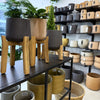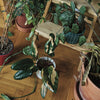Known and unknown Syngonium

Syngonium is a genus of aron-like climbing plants (aroids) native to tropical rainforests. They occur most in Central and South America, southern Mexico and the West Indies. In its homeland, it grows up to 20 meters high and is a woody vine that crawls up trees. In our domestic conditions, it will usually never grow to such dimensions, however, with proper care, it will certainly grow to admirable dimensions and will reward itself with beautiful colored and larger leaves.
Syngonium includes more than 150 species , and the interesting thing about this plant is that it continues to expand. It belongs to the extensive houseplants of many colors and shapes. In our parts, it is quite an unkissed maid. In stores, you can usually find only a few common species that also grow quickly, but their range is much larger and many species are classified as rare species because they are not yet widespread. Syngoniums are also called rosehip plant or rosehip vine . It got its name mainly thanks to its leaves, which are often arrow- or heart-shaped.
They contain oxalic acid, so be careful if you have pets or children at home, it is poisonous . When ingested, they cause severe pain in the mouth and strongly irritate the mucous membrane. After ingesting this plant in animals or small children, it is better to consult a doctor, a very strong allergic reaction could occur.
Unlike other aroids such as philodedrons or monsters, syngonias are smaller in stature in terms of their power and size of leaves, which is why they are also suitable for those who want to have a super plant at home, but do not have so much space. Let's take a look at how to care for syngonia and what makes them interesting!

Photo: Syngonium White butterfly grown only in water in a vase.
Loved but unloved?
Syngonias certainly have a number of their admirers all over the world, you can also be convinced by the marketplace on social networks, where they are widely traded and many growers are competing for which rarity they will buy somewhere. However, the truth is that they are not among the most popular maids. Why is that so? There is no certain answer to this, the culprit is probably that, although syngonias have many species and are widely distributed throughout the world, they are not often seen in shops, and a large number of species are quite inconspicuous among other types of plants. With our grandmothers, you may have noticed the most widespread species Syngonium podophyllum White Butterfly or Syngonium podophyllum Angustatum , which was the most widespread species in the Czech Republic in the past decades. Today, we have a much wider offer and it is possible to get almost any kind, although many of them are still abroad.
Syngonium care
Caring for most syngonias, except for a few species that usually have a distinct variegation, is very easy to care for and is a suitable plant for complete beginners and hydroponic enthusiasts. Just follow a few things.

Photo: Syngonium mojito has very brightly colored leaves
Light conditions
Thanks to its homeland under the crowns of trees, it is a plant that does not benefit its health from the sun's rays. It is usually happiest in medium diffused light or very bright diffused light, but no direct sun. Too much light is harmful . If the syngonium has too much light, defects may start to appear on the leaves and the plant will look sad. In the case of the sun's rays , the plant could die in a very short time, because the sun's rays will burn unsightly spots in the leaves, your substrate will dry out faster, and if you forget, the plant will also wither. In addition, the leaves can start to dry under the onslaught of the sun, and this is not a pretty sight for these houseplants.
Give the syngonia ideally the north side as close to the window as possible, or the east side. If you have an apartment on the south and southwest side, where the sun will shine in your windows almost all day, place your syngonium away from the window, away from the sun's rays, but in such a way as to allow as much diffused light as possible. Syngonias respond very well to light conditions and if they have little light, you can tell by the pale and discolored leaves. You can recognize a healthy syngonium by its distinctive colors. For syngonias, the rule is that the lighter the species , the more light , for syngonias with darker shades , less light or even partial shade is sufficient. Such Syngonium Neon robusta "pink" will even repay you in direct sunlight with a beautiful color that would be difficult to obtain in the shade.
Topping and environment
Syngonia love high air humidity . These are not drought-loving plants, although even in such conditions you will manage to grow them well. In order to give the plant maximum comfort, we recommend buying an air humidifier for your apartment, placing it in a place at home where it is not too dry and if you are crazy about growing, syngonia are in the TOP places for growing in hydroponics . If you don't want to have hi-tech at home for your maids, syngonia will love you for the frequent dewing of the leaves .
Substrate
Syngoniums will do well with an aerated substrate , in which not too much water will be retained. The plant does not thrive in standing water. You can, for example, use a regular substrate with perlite and adhere to moderate but more frequent watering and let the substrate dry out slightly before the next watering. You can use aroid substrate , which is the most suitable alternative, or you can mix the substrate yourself. It is important that the plant is not in an earthy soil that retains too much water and has sufficient drainage. Be sure to add expanded clay drainage to the bottom of the pot.
A little tip for growing. 💡 Plant the plant in a suitable substrate, add expanded clay drainage to the bottom. Add the flower pot to a container larger than the flower pot and add a 5-7 cm high drainage made of expanded clay to the bottom so that you can cover the bottom of the container with water. This will create bottom moisture and the plant will pull its roots downwards. You will not have to water the plant from above, but from below.
Martin
Hydroponics
The tip of the iceberg, which not many people venture into, but it's a great shame. Do you know what hydroponics is? In short, it is about growing plants using water without a substrate. Special zeolite substrates are used for hydroponics, e.g. Managreen , you can also use perlite itself, expanded clay , peat moss , Seramis and others. You can even use water alone without any substrates at all. The point is that the plant has a clean root system that feeds on the moisture of the air that is in a closed container or directly from water. If you use e.g. peat moss or Managreen substrate, the root system will take all the nutrients from the elements that absorb these highly porous materials and the roots will then "suck" them. We will write more about hydroponics in the next article, which you should not miss.

Photo: Syngonium Pixie after cleaning the root and transferring it to hydroponics
Do you want to try hydroponic growing? For beginners, we recommend first choosing the right plant and using cuttings that will grow roots in the water itself and let the plant grow only in water. The transition of the plant from the substrate to the water takes time and the plant may die.
TIP on rooting 💡 The best option when switching to hydroponics is, if the housekeeper allows you, to cut cuttings with aerial roots from the plant. If the plant does not have aerial roots, wait for them to form. Without an aerial root, your stem will root very poorly or not at all. Get a peat bog, and put the cuttings in it. Ideally in a glass or other transparent container and keep the peat always moist. The plant will release a root system in a relatively short time. If you do everything right, the plant can be grown in a peat bog for a long time under certain conditions, or you can then move it to a more permanent container with a hydroponic substrate or just in water. Don't forget to fertilize.
Martin
More about bog we wrote in the previous article.
Transplantation and propagation
Syngonia are easy to transplant and propagate.
The plant is suitable for transplanting if the roots climb out of the pot and the entire bundle is filled with roots. Syngonia needs to be transplanted approximately once every 2 years, always into a slightly larger pot. If the plant seems to be struggling, make sure you have the right substrate. If it is unsuitable, consider transplanting it to a higher quality substrate.
Breeding Syngonia has never been easier. In older plants, young shoots are formed at the root of the plant, which gradually separate from the plant, so young shoots can be split off after a while, which start to grow quite soon. A simpler alternative is to shorten the plant with a cutting over time, by cutting a twig ideally with one leaf and part of the stem, which must contain an aerial root. Place it in a peat bog or in water so that the aerial root is submerged , which will release a root after a while. In syngonia, it takes about 1-4 weeks, depending on the size of the plant, before it puts out another leaf, which gives rise to another branch.
Diseases and pests
Syngonia are very susceptible to whiteflies and thrips , which we wrote about in the previous article. Be very careful with these little critters as they can kill the plant and unfortunately they are almost invisible to the first eye, especially in the early stages when they are not that big. If you have a plant in a suitable place, you keep watering and there has been no sunburn and yet it seems to you that the plant is withering or its leaves turn yellow, check it carefully, these 2 parasites that feed on the plant and suck it up can often be the culprit. The most effective against these pests is, for example, Vertimec for weevils and Careo Substral for thrips.

Photo: Syngonium Pink splash Allusion belongs to the rarer species with pink spots
Syngonia
As we mentioned at the beginning, there are many syngonias, let's take a look at the most common species and a few rare species that can be found here. The most widespread and fastest-growing syngonias undoubtedly include Syngonium podophyllum White Butterfly , Syngonium Pixie , which is more compact in stature with smaller leaves, and also Syngonium Neon robusta "pink", which pleases with pink leaves. Some syngonias have a different shape of leaves in the shape of three leaves and grow much more slowly, they include, for example, Syngonium podophyllum Angustatum , Syngonium Pink Splash , which is also among rare species, or Syngonium Trileaf Wonder . A very interesting variant is Syngonium Wendlandii , which has very dark leaves with a white tinge in the middle and its leaves are velvety. For fans of darker leaves, variants such as Syngonium Dark Maria , Syngonium Berry or Syngonium Red Arrow will please
Among the syngonia there are dozens of rare species that are very hard to find and have interesting color combinations. The more affordable ones include the already mentioned Pink Splash , Syngonium Albo variegata with white variegation, Syngonium Aurea variegata with yellow variegation, Syngonium Frosted heart "Ice frost" which, unlike the others, has completely different, rather oval leaves. But the lines are much longer, e.g. Syngonium Pink spash allusion (photo), Syngonium Mojito , Syngonium Chiapense variegata, Syngonium pink Splash tricolor, Syngonium Batik, Syngonium Confetti and Milk Confetti etc.
The interestingness of the leaves
Syngonia are interesting in their growth, in their youth they are plants that do not need support, but the bigger they are, the more they need it. The best choice for such cultivation is a peat stick , or coconut bar , which we do not recommend too much, because it binds moisture poorly. Syngonia changes the shape of the leaves in old age, so it is interesting to watch the growth of this plant from the beginning to the top - each leaf will be slightly different. And the older, the bigger.
Happy growing and good luck and if you have any questions, don't hesitate to ask in the comments , we will be happy to advise you on growing syngonias.
Author: Martin Seidl
-
Posted in
Péče o pokojovky




